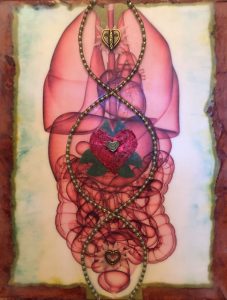organ principles
by julee snyder

In BMC we divide the body systems into categories of contents and container. Within the container formed by the musculo-skeletal-ligamantous framework we have the contents formed by the organs, glands, vasculature and fluids. The organs give us a sense of three-dimensionality due to their volume and weight. We will not address the physiological functions of the organs in this exploration, but rather their role in the support of bodily movement and posture.
Each organ has its own shape and density. And each organ has both mobility and motility. Organ mobility is the movement of the organ in response to voluntary movement or involuntary movement such as breathing. All organs should be free to glide and slide freely in relationship to other structures within 3-5 cm range of motion.
The viscera have an intrinsic motion called motility. The motility of each organ traces the path of its embryological development and migration. It is a subtle involuntary motion that can be sensed by the trained hand in 7-8 cycles per minute. Free and full motility suggests inherent health of the organ.
Each organ is wrapped in its own double-layered serous membrane – or connective tissue sack. The lungs are wrapped in pleura and the heart in pericardium. The peritoneum is a serous membrane containing most of the abdominal organs. The peritoneum that lines the abdominal cavity is called the parietal peritoneum. The visceral peritoneum covers the viscera. The potential space between the two is called the peritoneal cavity. There is approximately 50 ml of serous fluid (similar to synovial fluid) between the parietal and visceral layers.
Organs slip, slide and glide in relationship to each other because serous fluid lubricates the connective tissue layers between them. Serous fluid also creates a suction affect, which holds the connective tissue layers between structures to one another. Something else that holds organs to one another is turgor pressure – the tendency for the hollow organs to expand and occupy the maximal amount of space made available to them.
Organs have tone, which can be low or high, and affects its physiological function as well as its role in supporting the container. Organs are loosely held into place by ligaments, omenta, and mesenteries. They are not as dense or as strong as ligaments of joints.
Visceral Ligaments are a double fold of peritoneum that attach the organs to the body wall or to another organ. Most of these ligaments do not have the strength to support the organ but rather to help position them.
The Omenta is a double fold of peritoneum. There are two omenta in the abdomen and they both serve to connect the stomach to another organ. The lesser omentum attaches the stomach to the liver and the greater omentum attaches the stomach to the transverse colon.
A Mesentery is a double fold of pertineum that attaches some portion of the intestinal tract to the posterior aspect of the abdominal cavity. There is a mesentery each for the small intestine, the transverse colon and the sigmoid colon. The neuro-vascular structures travel along the mesentery. Mesenteries are connective tissue slings that allow for a great amount of movement of the organs to which they attach.
An organ can move and be moved in all three planes around its axes of rotation. Organs have proprioceptors that give feedback about where they are in space.
Waking-up your internal sense
- The first step in working with any structure is to find a map of the territory. Find a good picture or 3-dimensonal model to aid your somatization.
- Begin to imagine the structure within yourself, beginning to cultivate an internal sense. Clarify the location and the relationships. Clarify a sense of weight and density. This can come from what you sense or what you learn externally. But eventually your image and your experience will come together.
- It helps to hiss into or from the organ. It helps to sound.
- You may desire tactile feedback from a classmate or skilled practitioner. Allow yourself to be moved.
- Begin to move from the contents. This typically means that the container is less active to soften the habit and allow a new choice to emerge. Eventually they will integrate.
Notice in practice
As your awareness of the organs emerges, begin to notice how the organs support your practice. Notice organ tone in relationship to postural ease. Notice which organs are offering compressive support and which are offering suspension support.
Compression support occurs where the weight of the body is falling through the organs. If they have a balanced tone they participate in offering an organ base to the organs resting above them as they lift out of gravity. Suspension support occurs where the weight of the body is suspended from an organ that is lifting into space. Ex. In sphinx, the pelvic organs offer compression support and the heart, lungs and thyroid offer suspension support. In shoulder stand, the opposite is true.
Can you isolate the borders between organs? Do you have a sense that one organ can counter-rotate in relation to its neighbor?
Can you begin to sense how different organs support specific bones and joints?
Happy Practicing!!